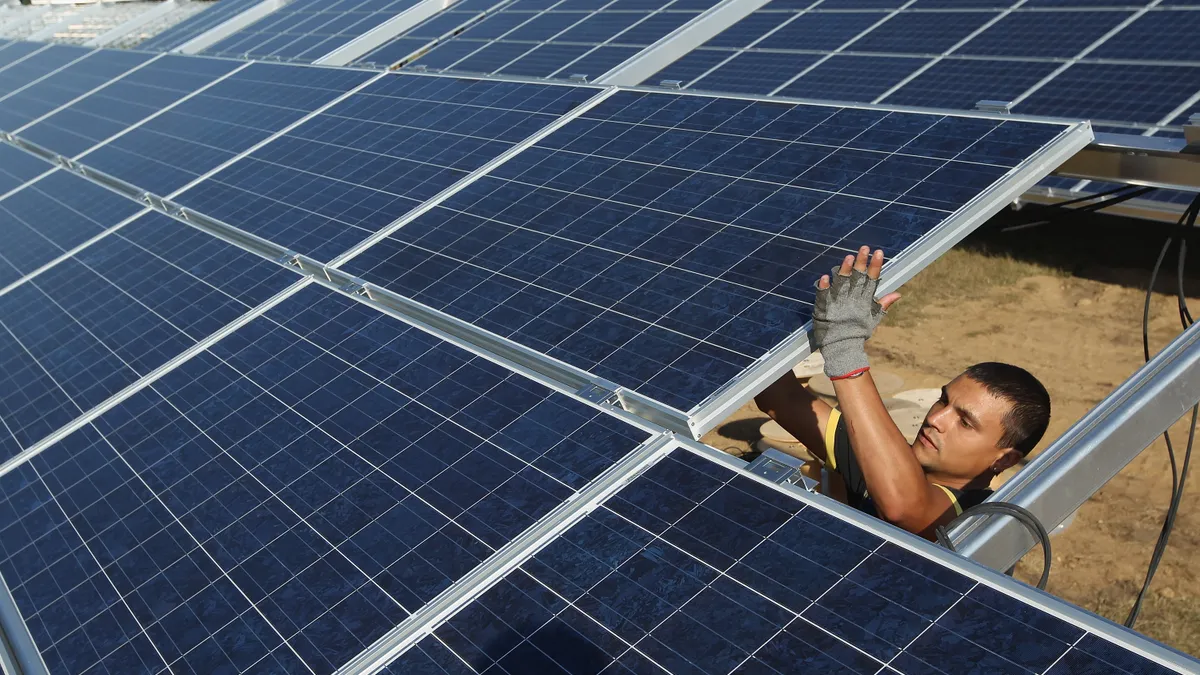Dive Brief:
- Pre-apprenticeship programs that recruit returning citizens are among innovative approaches workforce development experts are considering to meet high demand for renewable energy workers, participants said at an American Council on Renewable Energy forum Friday.
- The Solar Energy Industries Association’s vice president of equity and workforce development, Erika Symmonds, emphasized long-term considerations such as building trust with historically underserved communities, ensuring workers gain skills that are transferable and investing in management to produce good workplace culture.
- The panel also discussed the potential to recruit former fossil fuel workers while redeveloping brownfield sites for renewable energy production.
Dive Insight:
Panelist Austin Keyser, assistant to the International President for Government Affairs at the International Brotherhood of Electrical Workers, emphasized the need for apprenticeships and prevailing wage, which follows a union pay scale.
“Registered apprenticeship programs and the enforcement of a prevailing wage have been going on for a very long time in this country, and it's a very established set of principles,” he said.
A.J. Patton, the CEO of 548 Enterprise agreed with Keyser that there isn’t a need to reinvent the wheel from a labor standpoint, but said that the industry needs a “new ground game” as it looks to recruit workers over the next decade.
The Inflation Reduction Act incentivized renewable energy projects with 30% tax credits for the investment, production and manufacturing of clean energy. An additional 10% tax credit is available through the Environmental Protection Agency when developing those projects on a brownfield site.
Keyser said small communities near facilities such as coal plants have been left “absolutely destitute” by shut-downs and could benefit from projects that redevelop brownfield sites and “put people back to work.”
A labor shortage, a decline in workers entering the skilled trades and the lack of a robust trained workforce for the relatively new renewables industry is leading to high worker demand. A recent report from the National Renewable Energy Laboratory concluded that not enough workers are available to meet a national offshore wind goal of 30 GW by 2030.
The need for workers is an “existential issue” for the industry, said Jack Thirolf, the head of public policy and institutional affairs at Enel, during a panel on IRA implementation.
“The partnerships we have with local training schools, community colleges – we're not there yet, right?” he said. “[Worker demand] is a major challenge for us, and it’s also a huge opportunity for us. It's certainly been elevated, and it's gone from a critical issue to ‘the business doesn't work unless we get this right.’”
The 548 Energy Institute in Chicago has approached this by partnering with community groups to find a cohort for its pre-apprenticeship program, Patton said. 548 Enterprise originally began as an effort to make energy more affordable in low-income communities, then began working to increase equity in contracting, and upskill and train members of those communities.
“We actively engaged communities that have been overlooked, and said, ‘Hey, you got a returning citizens program? Give them to us, we'll pay them, we'll pay for the training, and we’re guaranteeing every graduate a job,’” Patton said.
Symmonds also emphasized the importance of investing in communities from a long-term standpoint, and not in a transactional way.
“Unfortunately, a lot of communities have been through situations where everybody's excited about something new, and training dollars come down, folks get training, and then end up in a situation where those jobs might not be here,” she said. “There's been a lot of disappointment in communities that have come in on these new opportunities. So building trust, following through, sticking with organizations for a long time, is going to be critical.”
Young people who are entering the workforce or will in a few years are attuned to the existential threat of the climate crisis, which can provide another avenue for recruitment, said Vanessa Benedetti, the director of resource strategy and real estate for the wind company Vestas.
“I think there's a huge heartstring that we can be pulling on here,” she said. “All of us who are here and involved in this industry, we care deeply about the future, so for us to not be leveraging that is a disservice to the whole industry.”














